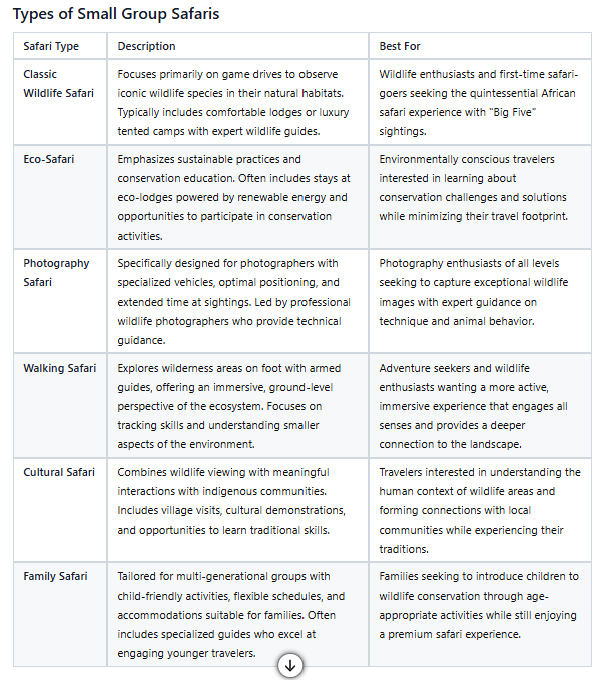Introduction to Small Group Safaris
Small group safaris represent a distinctive approach to wildlife exploration that has gained tremendous popularity among discerning travelers in recent years. Unlike traditional safari experiences that often involve large tour buses and dozens of participants, small group safaris typically limit participation to between 4-12 travelers, creating an intimate atmosphere that fosters deeper connections with both the environment and fellow adventurers.
These specialized safari experiences cater to travelers seeking authentic encounters with wildlife and local cultures without the constraints of mass tourism. The smaller size allows for access to exclusive locations that larger groups simply cannot reach, including private conservancies, remote wilderness areas, and authentic cultural interactions that would be impossible with a crowd.
What truly sets small group safaris apart is their ability to provide personalized attention. Guides can tailor experiences to match the specific interests of participants, whether that's spending extra time observing a pride of lions, focusing on bird photography, or learning about indigenous plant species. This flexibility creates a journey that feels custom-designed rather than following a rigid, one-size-fits-all itinerary that larger tours must adhere to.
As travelers increasingly seek meaningful experiences over mere sightseeing, small group safaris have emerged as the perfect solution for those who want to immerse themselves fully in the natural wonders of destinations like Africa, Asia, and South America while minimizing their environmental footprint and maximizing their personal connection to these extraordinary places.
Benefits of Small Group Safaris
- Enhanced Wildlife Viewing Opportunities: With fewer people, vehicles can approach animals more closely without causing disturbance. Small groups create less noise and commotion, allowing wildlife to behave more naturally. This often results in longer, more meaningful wildlife encounters as animals become less wary of your presence, providing exceptional photography opportunities and more authentic behavioral observations.
- Personalized Attention from Expert Guides: Guides can focus on individual interests and questions when managing smaller groups. This creates opportunities for in-depth learning about specific wildlife, ecosystems, or conservation efforts that interest you most. The intimate setting allows guides to share their most fascinating stories and insights that might get lost in larger groups, creating a more educational and enriching experience overall.
- Access to Exclusive Locations: Small groups can visit areas that remain off-limits to larger tours, including private conservancies, remote wilderness regions, and authentic cultural villages. These exclusive destinations often feature fewer vehicles and tourists, creating a more pristine safari experience with wildlife viewing areas all to yourselves. Many small-group operators have special arrangements with local communities for unique cultural interactions that wouldn't be practical with larger numbers.
- Reduced Environmental Impact: Fewer vehicles mean less disruption to wildlife and habitats, supporting conservation efforts in fragile ecosystems. Small group travel typically has a lower carbon footprint per traveler and often supports eco-friendly accommodations and practices. Many small group safari companies actively contribute to conservation initiatives and community development projects, allowing your tourism dollars to make a positive impact.
- Meaningful Connections: The intimate group setting fosters genuine friendships among like-minded travelers who share similar interests and values. Smaller numbers create space for authentic cultural exchanges with local communities without overwhelming them. These connections often become one of the most treasured aspects of the journey, with many travelers maintaining friendships long after the safari concludes.
What to Expect on a Small Group Safari
A small group safari offers a distinctly different experience from standard tours, beginning with your arrival at camp or lodge where you'll typically meet your fellow travelers during a welcome briefing. Most small group safaris include 4-12 participants, creating an intimate atmosphere where everyone quickly becomes acquainted. Your accommodations might range from luxury tented camps to boutique lodges, but they typically feature more character and local connection than large commercial properties.
Each day usually begins early, often before sunrise, when wildlife is most active. After a light breakfast, you'll embark on a morning game drive or activity lasting 3-4 hours. Your guide will communicate with other guides about wildlife sightings, but unlike larger tours, your small group can linger at interesting sightings without pressure to move on for the next busload of tourists. This flexibility allows for those magical moments when you might spend an hour watching lion cubs play or observing the intricate social dynamics of an elephant herd.
Mid-day typically includes lunch and relaxation time at camp, when wildlife is less active. This downtime provides opportunities for journaling, photography review, or informal discussions with your guide about the morning's observations. The intimate group size means these conversations can be tailored to your specific interests, whether that's bird identification, predator behavior, or ecosystem dynamics.
Afternoon activities resume as temperatures cool, often including another game drive, a walking safari, or perhaps a cultural visit to a local community.
The small group format allows your guide to adjust these activities based on the group's interests and energy levels. Evenings typically feature dinner under the stars, often around a campfire where stories are shared, and your guide might offer insights about nocturnal wildlife or astronomy. These communal experiences foster connections among travelers that frequently develop into lasting friendships.
Throughout the safari, you'll notice the guide's ability to provide personalized attention impossible in larger groups.
They'll remember your specific interests, adjust explanations to your knowledge level, and ensure everyone has optimal viewing positions for wildlife sightings. This personalized approach, combined with the flexibility to linger at exceptional sightings and access more remote areas, creates a safari experience that feels custom-designed rather than mass-produced.
Intimate Wildlife Encounters
- Unobstructed Viewing Opportunities: Small group safaris mean fewer people competing for the best observation positions. You'll have space to position yourself optimally for photography without jostling for angles, and guides can ensure everyone gets clear sightings without the frustration of crowded vehicles blocking views.
- Extended Time with Animals: Without the pressure to accommodate large numbers of tourists, small groups can linger at exceptional wildlife sightings. This patience often rewards travelers with witnessing fascinating behaviors rarely seen by larger groups, such as hunting sequences, complex social interactions, or rare mating rituals that require time to unfold.
- Off-the-Beaten-Path Encounters: Small group vehicles can navigate narrower tracks and more remote areas inaccessible to larger safari vehicles. This access often leads to discovering wildlife away from the crowds, including secretive species like leopards, aardvarks, or pangolins that typically avoid areas with heavy tourist traffic.
- Meaningful Behavioral Observations: The quiet, unobtrusive nature of small groups allows animals to behave more naturally. Guides can whisper detailed explanations about behaviors you're witnessing without disturbing the animals, creating educational moments that deepen your understanding of wildlife ecology and behavior.
- Nighttime Wildlife Experiences: Many small group safaris include night drives with spotlights to observe nocturnal species rarely seen during daylight hours. These intimate experiences might reveal elusive creatures like bush babies, civets, genets, and even the occasional aardvark or pangolin, adding another dimension to your wildlife encounters.
Expert Guides
The quality of your safari guide can transform a simple wildlife viewing trip into an extraordinary journey of discovery, and small group safaris excel in this crucial aspect. Unlike large tour operations where guides must cater to diverse interests simultaneously, small group safari guides can tailor their expertise to the specific interests of a handful of travelers.
These guides typically possess decades of experience in the field, with many holding advanced certifications in wildlife biology, ecology, or conservation. Their intimate knowledge of animal behavior allows them to anticipate wildlife movements and position your vehicle optimally before action unfolds. A skilled guide might recognize subtle signs—a distant vulture circling, a specific alarm call from an impala, or fresh tracks crossing a road—that lead to extraordinary sightings other groups miss entirely.
Beyond wildlife identification, expert guides serve as cultural ambassadors, conservation educators, and storytellers. They share indigenous knowledge about traditional plant uses, explain complex ecological relationships, and provide historical context for the landscapes you're exploring. Many have personal connections with local communities, facilitating authentic cultural interactions impossible for ordinary tourists to arrange independently.
The small group format allows these guides to adapt their teaching style to your level of interest and prior knowledge. Whether you're a first-time safari-goer thrilled by any animal sighting or a seasoned wildlife enthusiast seeking specific species, your guide can adjust the experience accordingly. This personalization extends to pace and focus—spending more time with birds if the group includes avid birders or focusing on predators if that's the collective interest.
Perhaps most valuably, these guides bring passion and personal stories that transform factual information into memorable narratives. Their anecdotes about individual animals they've followed for years, conservation challenges they've witnessed firsthand, or remarkable wildlife behaviors they've documented create a deeper connection to the landscapes you're exploring.
Eco-friendly Options
- Solar-Powered Camps and Lodges: Many small group safari operators prioritize accommodations that run entirely on renewable energy. These eco-lodges often feature sophisticated solar systems that power everything from lighting to water heating, minimizing environmental impact while still providing comfortable amenities. The intimate size of these properties allows for innovative sustainability solutions that would be impractical for larger resorts.
- Water Conservation Initiatives: Small group safaris frequently incorporate advanced water management systems including rainwater harvesting, greywater recycling, and low-flow fixtures. Some camps employ innovative technologies like waterless composting toilets that significantly reduce water usage in arid environments where this resource is precious. These practices not only conserve water but often serve as educational models for sustainable living.
- Zero-Waste Approaches: Leading eco-safari companies implement comprehensive waste reduction strategies, eliminating single-use plastics and providing reusable water bottles. Many operations compost organic waste for use in staff gardens, recycle materials where facilities exist, and carefully transport remaining waste to proper disposal facilities. These practices minimize the ecological footprint of your safari while setting standards for responsible tourism.
- Carbon Offset Programs: Environmentally conscious safari operators often calculate and offset the carbon emissions associated with your journey through verified carbon offset projects. These might include supporting local reforestation initiatives, funding renewable energy projects in nearby communities, or investing in efficient cookstove programs that reduce deforestation. Some companies even include these offsets automatically in your safari cost.
- Community Conservation Partnerships: The most progressive small group safaris collaborate with local communities to create economic alternatives to activities that harm wildlife. These partnerships might include hiring former poachers as anti-poaching rangers, training community members as guides, or establishing revenue-sharing agreements that fund local schools and healthcare facilities. These initiatives create tangible incentives for conservation while enhancing your travel experience through authentic cultural connections.
Wildlife Conservation Tours
Small group safaris increasingly incorporate meaningful conservation components that transform travelers from passive observers into active participants in wildlife protection efforts. These specialized experiences offer unique behind-the-scenes access to conservation projects rarely available to the general public, creating both educational value and lasting impact.
Many conservation-focused safaris partner with research organizations conducting vital work in wildlife monitoring and protection. Participants might assist researchers in collecting field data, setting up camera traps to monitor elusive species, or even helping with non-invasive sampling techniques that contribute to scientific understanding. These hands-on experiences provide insights into the scientific methods underpinning conservation while contributing tangibly to ongoing research efforts.
Beyond direct participation, conservation safaris often include exclusive presentations by leading wildlife biologists, veterinarians, and anti-poaching specialists working on the frontlines of species protection. These intimate discussions allow travelers to understand complex conservation challenges from those directly involved in solving them. The small group format encourages meaningful dialogue impossible in larger tour settings, where participants can ask detailed questions and engage deeply with conservation professionals.
Many conservation-oriented safari companies direct a significant portion of their profits directly to wildlife protection initiatives. This financial support might fund anti-poaching patrols, wildlife rehabilitation centers, habitat restoration projects, or community conservation education. By choosing these operators, travelers ensure their tourism dollars create positive impacts that extend far beyond their visit.
Perhaps most importantly, these experiences foster a deeper emotional connection to wildlife and wild places that inspires continued conservation support long after travelers return home. Many participants become lifelong advocates for the species and ecosystems they've encountered, continuing to support conservation organizations, sharing their experiences to raise awareness, and making lifestyle changes that reflect their enhanced environmental consciousness.
Packing Tips for Small Group Safaris
- Neutral-Colored, Layered Clothing: Pack earth-toned garments (khaki, olive, tan) that won't startle wildlife or show dust. Mornings and evenings can be surprisingly cool even in tropical regions, so bring lightweight long sleeves and pants that can be removed as temperatures rise. Quick-dry fabrics with UV protection are ideal, as they can be hand-washed and dry overnight, allowing you to pack fewer items overall.
- Quality Optics and Camera Equipment: A good pair of binoculars (8x42 or 10x42 recommended) will significantly enhance wildlife viewing. For photography, bring the longest telephoto lens you can manage, spare batteries, and ample memory cards. Consider a bean bag or small tripod for stability in safari vehicles. A dust-proof camera bag and lens cleaning supplies are essential in the often dusty conditions.
- Practical Accessories: A wide-brimmed hat with a chin strap (to prevent it blowing off during game drives), polarized sunglasses, and a bandana or buff (which can serve as sun protection, dust mask, or cooling device when wet) are safari essentials. A headlamp or small flashlight is crucial for navigating camps after dark, and a small daypack keeps essentials accessible during activities.
- Health and Comfort Items: Pack high-SPF sunscreen, insect repellent containing DEET or picaridin, and any personal medications in your carry-on luggage. Hand sanitizer, wet wipes, and a quick-dry travel towel prove invaluable in remote settings. Consider bringing electrolyte packets to maintain hydration in hot climates and any special dietary items you might need.
- Appropriate Footwear: Comfortable, closed-toe walking shoes or lightweight hiking boots are essential for walking safaris and uneven terrain around camps. Include a pair of comfortable sandals for relaxing at camp. Moisture-wicking socks prevent blisters during activities, and having several pairs allows for washing and rotation during longer safaris.
- Minimal and Practical Toiletries: Many safari accommodations provide basic toiletries, so check in advance. Biodegradable options are preferable in eco-sensitive areas. Dry shampoo can be useful where water is limited, and multipurpose products (like combination sunscreen/insect repellent or shampoo/body wash) save space and weight in typically restricted luggage allowances on small aircraft transfers.






